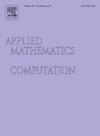改进WENO有限差分法:处理多重不连续点
IF 3.4
2区 数学
Q1 MATHEMATICS, APPLIED
引用次数: 0
摘要
经典加权基本非振荡法(WENO)在求解双曲型守恒律方面表现良好,但由于使用等宽质料,在处理多个不连续点时可能会遇到数值不稳定性问题。为了克服这一问题,我们提出了一种改进的WENO有限差分法,即WENO-rp2。WENO-rp2使用了r+2个候选材料,可分为两组,第一组S1由经典的r点材料组成,另一组S2由2个2点材料组成。然后,通过引入类似teno的开关机制,如果经典的WENO-rp2不能处理多个不连续或偏差过大,则使用S2进行最终的WENO-rp2重构,否则使用S1。通过这样做,WENO-rp2在光滑区域保持了最优(2r−1)阶精度,避免了多个不连续点附近的非物理振荡,更加中心化,但没有显著增加计算成本和数值耗散。本文章由计算机程序翻译,如有差异,请以英文原文为准。
Improved WENO finite difference method: Treating the multiple discontinuities
The classical weighted essentially non-oscillatory method (WENO) performs well in solving hyperbolic conservation laws, but may encounter the numerical instability while treating multiple discontinuities due to the use of equal-width substencils. In order to overcome this problem, we propose an improved WENO finite difference method, namely WENO-rp2. The WENO-rp2 uses candidate substencils, which can be divided into two groups, the first group consists of the classical r r-point substencils and the other group consists of 2 2-point substencils. Then by introducing a TENO-like switching mechanism, is used for the final WENO-rp2 reconstruction if the classical one can not handle the multiple discontinuities or is too biased, otherwise is used. By doing so, the WENO-rp2 maintains the optimal th order of accuracy in the smooth region, avoids the non-physical oscillation near multiple discontinuities, and is more central, but does not significantly increase the computational cost and numerical dissipation.
求助全文
通过发布文献求助,成功后即可免费获取论文全文。
去求助
来源期刊
CiteScore
7.90
自引率
10.00%
发文量
755
审稿时长
36 days
期刊介绍:
Applied Mathematics and Computation addresses work at the interface between applied mathematics, numerical computation, and applications of systems – oriented ideas to the physical, biological, social, and behavioral sciences, and emphasizes papers of a computational nature focusing on new algorithms, their analysis and numerical results.
In addition to presenting research papers, Applied Mathematics and Computation publishes review articles and single–topics issues.

 求助内容:
求助内容: 应助结果提醒方式:
应助结果提醒方式:


